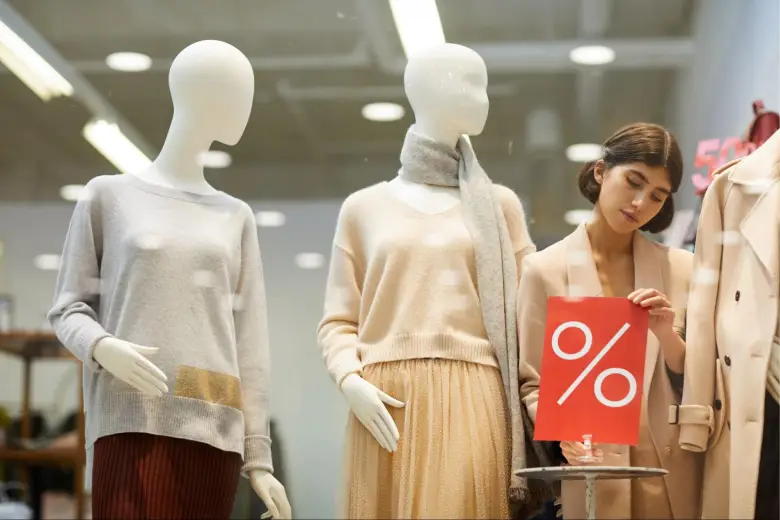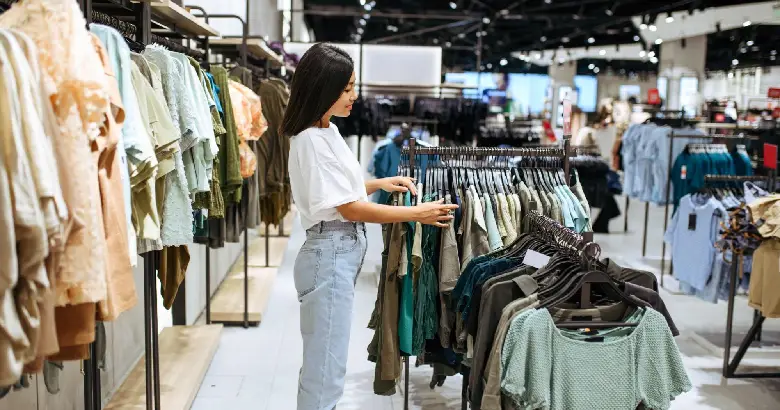What can you expect to earn as a visual merchandiser in the US? We outline salaries in the field, negotiation techniques, and key visual merchandising sectors, in this holistic guide.
Visual merchandising is a creative and dynamic career choice that blends design, strategy, and knowledge of human psychology to enhance the in-store and online shopping experience, encouraging purchases and boosting a brand’s sales. From designing elegant window displays that lure customers into stores to crafting engaging visual stories that inspire customers to try out products, the visual merchandiser does it all. The role is not only rewarding, but it’s also seeing growing demand across sectors in the US.
But what can you expect to earn as a visual merchandiser? And what is your earning potential in this role as you progress through your career? In this article, we’ll be answering these questions, arming you with the information you need to successfully negotiate your salary and make strategic decisions about where you want to be in one or ten year’s time.
Contents:
- What does a visual merchandiser do?
- Visual merchandiser job market and demand in the US
- Visual merchandiser job salaries in the US, from junior to senior
- Different sectors in visual merchandising (and example salaries)
- What’s the path to becoming a visual merchandiser?
- How to handle your visual merchandiser salary negotiation
- Conclusion
Ready to learn more about salaries in visual merchandising? Let’s dive into the details.

What does a visual merchandiser do?
Working closely with store managers and brands, a visual merchandiser makes data-driven decisions about how products are arranged and presented in stores and store windows to grab customers’ attention and encourage sales. They use signage, colors, lighting, product placement, store layout, arrangement, and visual storytelling to get the right products in front of target customers and craft a welcoming and inspiring environment that leads to positive customer-brand experiences.
A visual merchandiser makes their in-store visual design decisions by monitoring customer sales and behavior data closely and studying the latest trends in their industry. By knowing their target audience intimately and staying ahead of industry developments, they can create innovative displays that speak directly to their customers’ needs and desires.
Another core responsibility of the visual designer is to integrate a brand’s visual identity into displays. They do this by incorporating elements of the brand’s visual identity like its color palette, typography, and logo into their displays, making the brand instantly recognizable to customers. When this is done effectively, a visual merchandiser bridges the gap between a customer’s online and offline shopping experiences with the brand, fostering a consistent and cohesive aesthetic that nurtures loyalty and builds trust.
The following are the typical responsibilities of the visual merchandiser.
- Create and implement a visual merchandising strategy that aligns with the store brand and business targets
- Collaborate with stores, brand managers, marketing specialists, and buyers on promotions and advertising campaigns
- Organize store layouts, design product displays, and procure display materials
- Manage the installment of in-store and window displays, points of purchase, and signage
- Maintain coherent visual storytelling and branding throughout all stores
- Update the displays when new products or campaigns launch.
- Stay informed of industry trends and customer preferences

Visual merchandiser job market and demand in the US
If you’re thinking of a career in visual merchandising, then you’re in luck. The employment landscape for visual merchandisers in the US is looking extremely positive right now, with the projected job growth rate of 10% between 2018 and 2028 showing no signs of slowing down. In fact, in a sector that currently boasts more than 74,351 active job openings, over the next decade we can expect to see around 12,000 more opportunities added to that vacancy list, with visual merchandisers having a choice of roles from a wide range of lucrative industries such as retail, e-commerce, wholesale, electronics, homeware, and luxury fashion.
Visual merchandiser job salaries in the US, from junior to senior
When it comes to wages, salaries for visual merchandisers have seen a 15% increase in the last five years alone, with the average yearly salary in the US now stable at $38,297 (Salary.com). A junior or entry-level visual merchandiser’s salary is typically $31,000 (Zippia), a mid-level visual merchandiser’s yearly salary is on average $38,037 (Zippia), and a senior visual merchandiser can expect around $45,000 (Indeed). However, those who choose to work as visual merchandising consultants in a freelance capacity can charge significantly more for their expertise, with very senior specialists commanding salaries of up to $98,190 per year (Glassdoor) in selected industries.

|
Seniority level of visual merchandiser |
Average salary in the US |
|---|---|
|
Junior visual merchandiser |
$31,000 (Zippia) |
|
Mid-level visual merchandiser |
$38,037 (Zippia), |
|
Senior visual merchandiser |
$45,000 (Indeed) |
|
Specialist visual merchandiser |
$98,190 (Glassdoor) |
Visual merchandiser job salaries in major US states
|
US state |
Average visual merchandiser salary |
|---|---|
|
New York |
$50,859 |
|
Pennsylvania |
$49,662 |
|
North Dakota |
$36,235 |
|
Massachusetts |
$43,173 |
|
Minnesota |
$34,866 |
|
California |
$47,527 |
|
Virginia |
$45,509 |
|
Wisconsin |
$45,392 |
Source: Zippia.com
Different sectors in visual merchandising (and salaries)
Four leading industries where you are likely to find visual merchandising roles are fashion retail, e-commerce, homeware, and food retail. Let’s look at what you might expect from a position in one of these sectors and example salaries.
1. Fashion
In the fashion retail industry, the visual merchandiser works closely with the brand to create an attractive and welcoming environment that showcases products and entices customers to make purchases. The role involves the stylish and cohesive presentation of clothing, accessories, and other products in window displays and throughout the store. A key part of the role is ensuring that the brand’s visual identity is accurately reflected in product arrangements, store decoration, and in-store experiences. The visual merchandiser builds a bridge between a customer’s online and in-store experiences with a brand, enhancing the customer’s overall interaction, building trust, and fostering familiarity.
Core responsibilities include:
- Window and in-store display design, arrangement, and maintenance
- Product styling and arrangement in line with promotions and trends
- Store layout planning
- Seasonal displays
- Trend and market research
- Product placement
Example salaries:
- The salary for a Visual Merchandiser for H&M in the Mall of America is: $16.99-19.11 per hour.
- The salary for a Visual Merchandising Manager for Anthropologie is $36.06 per hour.
- The salary for an International Visual Merchandising Manager for Vuori is $115,000-130,000 per year.
2. E-commerce
A visual merchandiser working in e-commerce seeks to create attractive displays of products in an online portal to boost the shopping experience for customers, driving conversions and sales. They apply principles similar to an offline environment, optimizing product images, layouts, and labeling to align with the brand’s identity and help users find what they’re looking for. In addition to styling product photos, designing promotional banners, and reflecting the brand’s visual identity, the visual merchandiser also collaborates closely with the digital marketing team to analyze user data and implement their findings to ensure targeted and effective product promotions.
Core responsibilities include:
- Product image optimization
- Website layout and design
- Promotional content creation
- Product arrangement and categorization
- User research
- Testing
- Trend monitoring
Example salaries:
- The salary for this Online Visual Merchandiser for an e-commerce company is $30-$34 per hour.
- The salary for the Ecommerce Merchandiser at Petite Plume is $65,000-$75,000 a year
- The salary for Kipling/Eastpak/JanSport: Digital Site Merchandiser is $70,400-$88,000 a year.
3. Homeware and interior design
In the homeware and interior design sector, the visual merchandiser works on attractive displays within physical retail or commercial spaces, combining design principles, color theory, and spatial planning. Their goal is to engage shoppers in the store, support navigation throughout the space, guide them towards furniture and homeware products they might be interested in, and create an inspirational environment that boosts sales. From designing layouts and arranging furniture to selecting the room’s decor, lighting, and signage, the visual designer seeks to align the ambiance of the physical space with the brand’s identity. In this role, a visual merchandiser is expected to stay ahead of interior design and homeware trends and evolving customer behaviors to optimize product placement and find ways to maximize engagement within the space.
Core responsibilities include:
- In-store and window display design
- Product styling and arrangement
- Space planning
- Trend-based displays
- Market analysis
Example salaries:
- The salary for this Furniture Visual Designer role at American Furniture Warehouse is $22-$24 an hour.
- The salary for the Visual Merchandising Manager at Ardmore Home Design is $75,000-$85,000 a year
- The salary for the Visual Designer and Manager at Nell Hills is $30-$45 an hour
4. Food retail industry
Ever wondered who makes the decisions behind those enticing promotional displays in the supermarket? Whether it’s a pyramid of reduced price chocolate or a new range of organic baby food, it’s the visual merchandiser who analyzes extensive customer data to decide which food products are placed where in the aisles to get the most attention from their target customers. Psychology plays a huge part in the supermarket visual merchandiser’s job. They need to understand exactly how shoppers navigate the store in order to know where and how to position displays that will interest them. This involves a deep understanding of the supermarket’s layout, customer flow, and the psychology of shopping as well as trends in customer behavior.
Core responsibilities include:
- Store layout and planogram design
- Product display and arrangement
- Seasonal displays and promotions
- Signage
- Display maintenance
- Product rotation
- Trend research
- Customer research
Example salaries:
- The salary for the Retail Merchandiser role at Grocery Outlet is $22.50 an hour.
- The salary for the Part-Time Retail Display Merchandiser at Kellanova starts at $17.00 – $17.25 an hour.
- The salary for the Merchandiser at ABARTA Coca-Cola Beverages is $36,000-$60,000.

What’s the path to becoming a visual merchandiser?
Irrespective of the particular sector you dream of working in, you’ll need a combination of education and experience to land a role in visual merchandising. Here’s what you’ve got to do to get on the right path to this creative career.
1. Education
An education in visual merchandising is not essential to becoming a visual merchandiser, but it certainly helps. While it’s possible to work your way up through the ranks in retail–e.g.starting in an entry-level shop assistant position to gain firsthand knowledge of product displays, customer behavior, and store layout–a solid education in visual merchandising can enable you to land the role you want more quickly, with a higher starting salary, too.
Many universities offer visual merchandising degree programs and master’s programs which provide students with what is typically a full-time, intensive education in the field. While these courses can be theory-heavy, increasingly universities are partnering with organizations to offer internships, industry guest speakers, and the opportunity for students to collaborate on real-world projects, helping them build up that all-important hands-on experience required to succeed.
For those looking for a more flexible and affordable study option, online courses are a great option. In addition to a comprehensive education in the field of visual merchandising, many schools assist students with creating a professional portfolio of work and career guidance, helping land a job in the field upon completing the course.
One of the main benefits of studying with an online design course provider is that students can study at a pace that complements their lifestyle or other work commitments without missing out on the one-to-one mentoring, theory, or practical experience needed to succeed in the role. Many online course providers also offer certification to students who complete their visual merchandising courses. This helps students demonstrate their commitment to their careers and their knowledge of the field at job interviews further down the line.
2. Experience
Getting some hands-on experience will be crucial to learning your trade as a visual merchandiser. There are a few different ways you can do this.
One effective way to learn directly from a professional in the field while getting on-the-job experience is by shadowing a visual merchandiser in your area. While this is a great opportunity to observe and learn, it may also be a chance to assist with small tasks or projects. Either way, this is your chance to ask questions directly of someone who is doing your dream job. They will likely have tips for newcomers to the field so listen carefully. This advice will be invaluable when you start applying for your first paid positions.
Another popular method for gaining hands-on experience is to approach a local, independent store yourself. By offering your visual merchandising skills free of charge, you’re in with a good chance of being given permission to create a window display or some in-store product displays that attract customers and boost sales. If this opportunity arises, be sure to take photographs of your work and track the success of your displays. Projects like these are perfect for building your portfolio and demonstrating to potential employers your passion for your new career.
Finally, a traditional work experience placement within a retail environment is a great way to build on your skills, get your name in front of potential recruiters, and learn how visual merchandising works from inside a large brand. Numerous high-street fashion and retail brands offer apprenticeships and work experience placements for those looking to launch careers in the sector, with some even offering specific visual merchandising placements. While these can be competitive, this is a fantastic opportunity that can lead to paid employment in an entry-level position.
How to handle your visual merchandiser salary negotiation
Few of us relish salary negotiations. It can feel awkward asking for a certain amount of money, even if we know we are entitled to it. However, arming yourself with the tools needed to negotiate your salary is integral to managing your visual merchandising career. Here’s our advice for a successful discussion that will leave you confident to command the salary you deserve.
1. Align your salary request with the market
Research is your friend when it comes to salary negotiations. Dig into the salaries for visual merchandisers working at your level of experience in your area. This will guide you in asking for a salary that aligns with the market.
Our top tips:
- Check out sites like Glassdoor and Salary.com for the latest salary data
- Politely approach those working in the industry to enquire about what you could ask for
- Research salaries at the company you are applying for to get a feel for their budget
- Consider the size of the team and your responsibilities
- If the job is in a different area (or country) you’ll need to take into account the local cost of living to see if it matches the quality of life you would expect
2. Be specific
Studies show that the more specific you can be when asked to provide your salary request, the more likely you are to get a counter offer that is close to what you want. When you provide a precise figure it demonstrates to employers that you have done your research into salaries for the role and are well-informed of the amount you are entitled to. This in turn prompts the employer to make only minor adjustments to the figure before making their own offer.
Conclusion
In this article, we’ve run you through the salaries, job outlook, sectors, career paths, and salary negotiations of visual merchandisers in the US. We hope that, armed with this knowledge, you feel confident in exploring this career path and the opportunities, both financial and otherwise, that it offers to talented and creative individuals. With skilled visual merchandisers becoming increasingly sought-after by brands and stores across the US, this is a career that is likely to offer stability and significant growth in the coming years.
Next Steps
If you enjoyed this article and would like to learn more about interior design, head back to AND Academy’s blog for more articles like this one. We also recommend you check out this project by AND Learner, Sonali Khajuria to get inspiration for your next interior design project.
In case you need further assistance, here are some resources to consider:
- Watch this session by Snehanshu Mukherjee, Founding Partner at T.E.A.M and Mansi Almadi, an Interior Designer at Studio Lotus
- Talk to a course advisor to discuss how you can transform your career with one of our courses.
- Check out our Interior Design courses – all courses are taught through live, interactive classes by industry experts.
- Take advantage of our scholarship and funding options to overcome any financial hurdle on the path of your career transformation.
Note: All information and/or data from external sources is believed to be accurate as of the date of publication.









